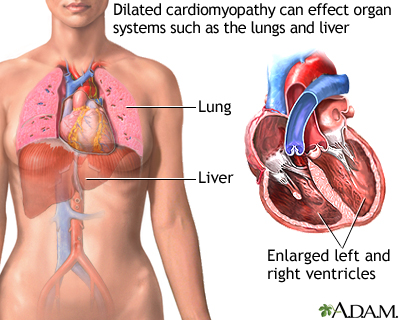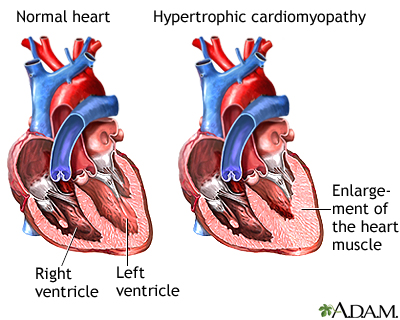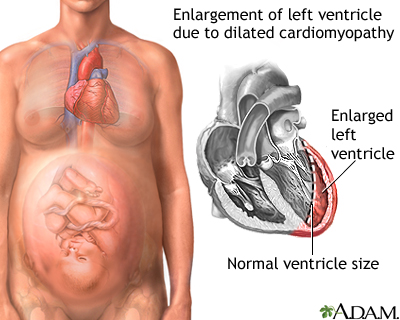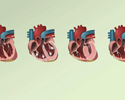Cardiomyopathy
Cardiomyopathy is disease in which the heart muscle becomes weakened, stretched, or has another structural problem. It often occurs when the heart cannot pump or function well.
Most people with cardiomyopathy have heart failure .
Heart failure
Heart failure is a condition in which the heart is no longer able to pump oxygen-rich blood to the rest of the body efficiently. This causes symptom...

Causes
There are many types of cardiomyopathy, with different causes. Some of the more common ones are:
- Dilated cardiomyopathy is a condition in which the heart becomes weak and the chambers get large. As a result, the heart cannot pump enough blood out to the body. It can be caused by many medical problems.
- Hypertrophic cardiomyopathy (HCM) is a condition in which the heart muscle becomes thick. This makes it harder for blood to leave the heart. This type of cardiomyopathy is most often passed down through families.
- Ischemic cardiomyopathy is caused by a narrowing of the arteries that supply the heart with blood. It makes the heart walls thin so they DO NOT pump well.
- Restrictive cardiomyopathy is a group of disorders. The heart chambers are unable to fill with blood because the heart muscle is stiff. The most common causes of this type of cardiomyopathy are amyloidosis and scarring of the heart from an unknown cause.
- Peripartum cardiomyopathy occurs during pregnancy or in the first 5 months afterward.
Treatment
When possible, the cause of cardiomyopathy is treated. Medicines and lifestyle changes are often needed to treat the symptoms of heart failure , angina and abnormal heart rhythms .
Heart failure
Heart failure is a condition in which the heart is no longer able to pump oxygen-rich blood to the rest of the body efficiently. This causes symptom...

Angina
Angina is a type of chest discomfort or pain due to poor blood flow through the blood vessels (coronary vessels) of the heart muscle (myocardium). Th...
Abnormal heart rhythms
An arrhythmia is a disorder of the heart rate (pulse) or heart rhythm. The heart can beat too fast (tachycardia), too slow (bradycardia), or irregul...

Procedures or surgeries may also be used, including:
- A defibrillator that sends an electrical pulse to stop life-threatening abnormal heart rhythms
- A pacemaker that treats a slow heart rate or helps both sides of the heart beat at the same time
-
Coronary artery bypass
(CABG) surgery or
angioplasty
that may improve blood flow to the damaged or weakened heart muscle
Coronary artery bypass
Heart bypass surgery creates a new route, called a bypass, for blood and oxygen to go around a blockage to reach your heart.
 ImageRead Article Now Book Mark Article
ImageRead Article Now Book Mark ArticleAngioplasty
Angioplasty is a procedure to open narrowed or blocked blood vessels that supply blood to the heart. These blood vessels are called the coronary art...
 ImageRead Article Now Book Mark Article
ImageRead Article Now Book Mark Article -
Heart transplant
that may be tried when all other treatments have failed
Heart transplant
A heart transplant is surgery to remove a damaged or diseased heart and replace it with a healthy donor heart.
 ImageRead Article Now Book Mark Article
ImageRead Article Now Book Mark Article
Recently, implantable artificial heart pumps have been developed. These may be used for very severe cases. However, not all people need or are able to have this advanced treatment.
Outlook (Prognosis)
The outlook depends on many different things, including:
- Cause and type of cardiomyopathy
- How well the condition responds to treatment
- The severity of the heart problem
Heart failure is most often a long-term (chronic) illness. It may get worse over time. Some people develop severe heart failure. In this case, medicines, surgery, and other treatments may no longer help.
People with certain types of cardiomyopathy are at risk for dangerous heart rhythm problems.
References
Falk RH, Hershberger RE. The dilated, restrictive, and infiltrative cardiomyopathies. In: Bonow RO, Mann DL, Zipes DP, Libby P, Braunwald E, eds. Braunwald's Heart Disease: A Textbook of Cardiovascular Medicine . 10th ed. Philadelphia, PA: Elsevier Saunders; 2015:chap 65.
McKenna WJ, Elliott P. Diseases of the myocardium and endocardium. In Goldman L, Schafer AI, eds. Goldman's Cecil Medicine . 25th ed. Philadelphia, PA: Elsevier Saunders; 2016:chap 60.
McMurray JJV, Pfeffer MA. Heart failure: management and diagnosis. In Goldman L, Schafer AI, eds. Goldman's Cecil Medicine . 25th ed. Philadelphia, PA: Elsevier Saunders; 2016:chap 59.
O'Connor CM, Rogers JG. Heart failure: pathophysiology and diagnosis. In Goldman L, Schafer AI, eds. Goldman's Cecil Medicine . 25th ed. Philadelphia, PA: Elsevier Saunders; 2016:chap 58.
-
Cardiomyopathy overview
Animation
-
Heart, section through the middle - illustration
The interior of the heart is composed of valves, chambers, and associated vessels.
Heart, section through the middle
illustration
-
Heart, front view - illustration
The external structures of the heart include the ventricles, atria, arteries and veins. Arteries carry blood away from the heart while veins carry blood into the heart. The vessels colored blue indicate the transport of blood with relatively low content of oxygen and high content of carbon dioxide. The vessels colored red indicate the transport of blood with relatively high content of oxygen and low content of carbon dioxide.
Heart, front view
illustration
-
Dilated cardiomyopathy - illustration
Dilated cardiomyopathy involves enlargement of the heart muscle and is the most common type of cardiomyopathy. The heart muscle is weakened and cannot pump blood efficiently. Decreased heart function affects the lungs, liver, and other body systems.
Dilated cardiomyopathy
illustration
-
Hypertrophic cardiomyopathy - illustration
Hypertrophic cardiomyopathy is the thickening of the muscles that make up the heart. The thickening may interfere with the normal functioning of the heart by: narrowing the outflow of the ventriclereducing the ability of the heart to relax and fill with blood during the relaxation phasereducing the ability of the valves of the heart to function properly narrowing the outflow of the ventricle reducing the ability of the heart to relax and fill with blood during the relaxation phase reducing the ability of the valves of the heart to function properly Any situation that increases the contraction or rate of contraction of the heart muscle can worsen these symptoms.
Hypertrophic cardiomyopathy
illustration
-
Peripartum cardiomyopathy - illustration
Peripartum cardiomyopathy is a rare disorder in which a weakened heart is diagnosed within the last month of pregnancy or within 5 months after delivery, without other identifiable causes for dysfunction of the heart. The heart muscle becomes enlarged and weakened and cannot pump blood efficiently. Decreased heart function affects the lungs, liver, and other body systems.
Peripartum cardiomyopathy
illustration
-
Heart, section through the middle - illustration
The interior of the heart is composed of valves, chambers, and associated vessels.
Heart, section through the middle
illustration
-
Heart, front view - illustration
The external structures of the heart include the ventricles, atria, arteries and veins. Arteries carry blood away from the heart while veins carry blood into the heart. The vessels colored blue indicate the transport of blood with relatively low content of oxygen and high content of carbon dioxide. The vessels colored red indicate the transport of blood with relatively high content of oxygen and low content of carbon dioxide.
Heart, front view
illustration
-
Dilated cardiomyopathy - illustration
Dilated cardiomyopathy involves enlargement of the heart muscle and is the most common type of cardiomyopathy. The heart muscle is weakened and cannot pump blood efficiently. Decreased heart function affects the lungs, liver, and other body systems.
Dilated cardiomyopathy
illustration
-
Hypertrophic cardiomyopathy - illustration
Hypertrophic cardiomyopathy is the thickening of the muscles that make up the heart. The thickening may interfere with the normal functioning of the heart by: narrowing the outflow of the ventriclereducing the ability of the heart to relax and fill with blood during the relaxation phasereducing the ability of the valves of the heart to function properly narrowing the outflow of the ventricle reducing the ability of the heart to relax and fill with blood during the relaxation phase reducing the ability of the valves of the heart to function properly Any situation that increases the contraction or rate of contraction of the heart muscle can worsen these symptoms.
Hypertrophic cardiomyopathy
illustration
-
Peripartum cardiomyopathy - illustration
Peripartum cardiomyopathy is a rare disorder in which a weakened heart is diagnosed within the last month of pregnancy or within 5 months after delivery, without other identifiable causes for dysfunction of the heart. The heart muscle becomes enlarged and weakened and cannot pump blood efficiently. Decreased heart function affects the lungs, liver, and other body systems.
Peripartum cardiomyopathy
illustration
-
Heart failure
(In-Depth)
Review Date: 5/5/2016
Reviewed By: Michael A. Chen, MD, PhD, Associate Professor of Medicine, Division of Cardiology, Harborview Medical Center, University of Washington Medical School, Seattle, WA. Also reviewed by David Zieve, MD, MHA, Isla Ogilvie, PhD, and the A.D.A.M. Editorial team.









